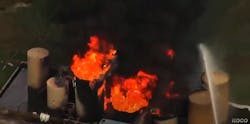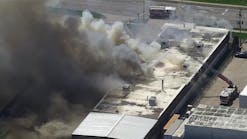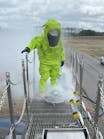Firefighters spend countless hours each year conducting on-scene size-ups of fire-related incidents. But how adequate is our training on conducting size-ups of hazardous materials incidents? What information should be included in such training to ensure that our crews have an efficient and effective response to the incident?
First-due size-up
Hazmat response teams are structured differently throughout the country. Most fire-based hazmat teams will not be the first unit responding to a hazmat emergency. The majority of the time, the first-due unit will contain emergency responders trained to the awareness or operations level. NFPA 472 states that emergency responders trained to the hazardous materials operations level should be able to “survey the incident to identify the containers and materials involved, determine whether hazardous materials/WMD have been released and evaluate the surrounding conditions.”
3 steps to a complete hazmat size-up
Firefighters trained to the operations level should be able to conduct a size-up and report the findings through an on-scene report. As all fire officers know, the size up of an incident becomes more effective with the level of knowledge and skill of the firefighter. With that in mind, let’s break down the overall process into three steps: 1) early impression, 2) research-driven information and 3) on-scene analysis.
Step 1: Early impression
The incident size-up begins when the call is initially dispatched. Dispatch information allows us to form the initial impression of the incident. This is a mental size-up process. We attempt to process the information and form an early idea of what has taken place, the current conditions, and the resources we may need to respond to the incident. There are several questions to consider in this process:
- What type of environment are we responding to? For example, is this incident outdoors or indoors? What are the concerns for life safety in this area? What potential exposures are of concern?
- What type of material is involved? For example, is it a solid, liquid or gas? Have we planned for a response involving the material? What resources are currently assigned?
The early impression we form is based upon the answers to these questions. This process is purely mental and can usually be accomplished within the first few seconds to minutes of initial response.
Step 2: Research-driven information
There are many computer-aided dispatch (CAD) systems and other programs that allow the user to store valuable premise information in a laptop or onboard tablet system. Pre-incident planning should be a high priority for any response to a facility, especially a known user or producer of hazardous materials in your community. The relevancy and speed of access to this information is important. If the information is well put together but stored in a three-ring binder at the fire station, it does not help when we have an emergency response at a specific site. Likewise, if we only input the location of the key box into the CAD system, we have missed the point entirely.
The ability of the emergency responder to know and comprehend emergency response information and use research material developed for emergency responders will be crucial to the success of the early stages of a hazmat response. Two great resources that every piece of responding equipment should have are the National Institute of Occupational Safety and Health (NIOSH) Pocket Guide to Chemical Hazards and the Department of Transportation’s Emergency Response Guidebook (ERG). Both guides contain a wealth of information and are fairly efficient for looking up information while responding to an incident.
Step 3: On-scene analysis
You have formed an early mental impression based on the information from dispatch and the preplan established for this site. You have conducted research using the NIOSH Guide and ERG on the way to the incident. You are now arriving on the scene. This is one of the most crucial times in the course of the emergency response. The ability to effectively communicate what you see early in an incident will allow the correct tactical decisions to be made.
Size-up process
We are the eyes and ears of the scene and need to clearly communicate what we are processing while approaching the scene.
The following should be processed when conducting the evaluation of the incident.
- Overall environment
- Occupancy
- Container and process recognition
Overall environment
What is your first impression of the overall scene? Is everyone running from the incident screaming for their lives, or is it relatively calm and appearing to be in normal operation? Is the material you were dispatched to water-reactive and is it currently raining? Is this a diesel spill from a saddle tank in the middle of winter or summer? How will the current temperature affect your response/plan to mitigate the incident? This is a “wide-angle” process, which allows the size-up of the overall site or area of concern.
The physical properties of the material we are responding to will have the greatest impact on our decision-making process. We need to be able to assess the material as a solid, liquid or gas. We can base our initial evacuation distances based on physical properties of the material.
Occupancy
Every fire department and hazmat response team should be trained on the known chemical users and producers within their response areas. The most efficient way to respond to an incident is to already have a game plan for the facility or processes involved in the emergency. However, there are several building clues that will assist in your size-up process upon your arrival.
The NFPA 704 system is specifically designed for emergency responders. The ability to read and understand the health, flammability, reactivity and special considerations will assist in your size-up process. One quick look at a facility will give you a clue of the hazards involved. Your eyes should be constantly trained on the outside of the structure for clues to the occupancy and use of the facility.
Figure 3 is labeled “Equipment Room” and “Anhydrous Ammonia.” This door should be a quick indicator that a compressor room is likely behind the door. Building signage and placarding are a great reference for the size-up of the occupancy and possible processes that may exist behind the doors and walls of the structure.
Tanks, piping, pressure vessels, and other attachments give indications that the facility is a user of hazardous materials. The tanks located in Figure 4 are part of the anhydrous ammonia refrigeration system at this facility. External alarms and flashing lights may also give indications that caution is needed when approaching the facility. Mentally processing the information should be ongoing throughout the course of the incident.
Container and process recognition
Containers have very specific sizes, shapes and devices used for the storage and transportation of hazardous materials. In the size-up process, we can gain much information based upon what type of container we see and what type of physical clues we can relay in our on-scene report.
Within a few seconds of arriving on the scene shown in Figure 5, we gain several clues. The first clue is the 55-gallon drum made of steel. The second clue is the red placard attached to the drum itself, which indicates flammability. The third clue is the material on the ground, which appears to be spilled coming from a leak in the drum.
It is very hard to estimate gallons of liquid on the ground. The best way to communicate the size of a spill is to estimate the size of the area on the ground; in this case, an area approximately 3 feet by 20 feet. The color and viscosity of the material are also very important. A dark brown sludge-type substance could be an oil product, while a clear liquid evaporating readily might indicate a much higher degree of flammability.
An example of an on-scene report for the scene in the picture would be, “Engine 2 is on the scene of a 55-gallon steel drum with a red placard. The drum appears to be leaking a light colored liquid that is evaporating readily in an area 3 feet by 20 feet. Engine 2 will be command.” This information will allow all other incoming units to be on the same page when selecting PPE and determining what equipment to bring up to the scene. In this case, a four-gas meter with combustible gas indicator (CGI) and firefighter turnout gear is a must.
As another example, consider Figure 6. The first clue when assessing this scene should be the UN number located on the side of the tank. A quick glance at the ERG will show that the product is liquefied petroleum gas (LPG). The second clue is the red color of the placard indicating flammability. The color, shape, and size of the vapor cloud should be clearly communicated in our initial on-scene size-up. “Engine 2 is on the scene of an MC331 leaking from the valve piping containing liquefied petroleum gas. The visible LP gas cloud is white in color and appears to be 4 feet by 4 feet in size. Engine 2 will be command.” The way we approach size up should be to “paint a picture” for the incoming units. The on-scene size-up should get everyone to visualize a leaking MC331 in their minds.
Efficient and effective size-up
The initial on-scene size-up is used to inform incoming responders of the current conditions and assist in the decision-making process for the hands-on tactical skills needed to efficiently and safely respond to the incident. The assessment of any hazard should always follow the established incident priorities within National Incident Management System (NIMS). Each decision made should follow the priorities of life safety, incident stabilization and property conservation. As you assess the situation and conduct a rapid risk assessment, each of these three incident priorities should always be your top consideration. Effective communication is key for a successful operation.
References
NFPA 472: Standard for Competence of Responders to Hazardous Materials/Weapons of Mass Destruction Incidents, 2013 Edition. In NFPA National Fire Codes Online. Retrieved from http://codesonline.nfpa.org
National Incident Management System, IV: Command and Management (p. 45) and Appendix B: Incident Command System (p. 89), (2008): www.fema.gov/pdf/emergency/nims/NIMS_core.pdf
National Institute for Occupational Safety and Health. (2016). NIOSH pocket guide to chemical hazards. Cincinnati, OH: U.S. Dept. of Health and Human Services, Public Health Service, Centers for Disease Control and Prevention, National Institute for Occupational Safety and Health. Retrieved from www.cdc.gov/niosh/npg
United States. Pipeline and Hazardous Materials Safety Administration (2012). 2012 Emergency Response Guidebook. Washington, D.C.: U.S. Dept. of Transportation, Pipeline and Hazardous Materials Safety Administration.
Nick Bonstell
NICK BONSTELL has been in the fire service for 19 years. He is currently the fire chief for the City of Zeeland, MI. Bonstell is also a contract hazardous materials instructor for the Center for Domestic Preparedness in Anniston, AL. His past experience includes being a hazardous materials technician on the State of Michigan Regional Response Team and the lieutenant of Hazardous Materials Planning for the City of Grand Rapids, MI. He holds a bachelor’s degree in occupational safety and health and an associate’s degree in fire science from Columbia Southern University. Bonstell also holds the ASP (Associate Safety Professional) designation from the Board of Certified Safety Professionals.






